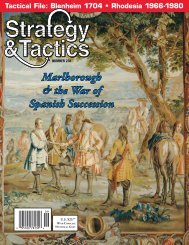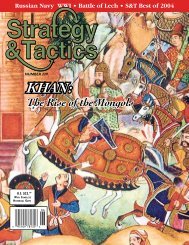COUNTERSTROKE AT SOLTSY - Strategy & Tactics Press
COUNTERSTROKE AT SOLTSY - Strategy & Tactics Press
COUNTERSTROKE AT SOLTSY - Strategy & Tactics Press
You also want an ePaper? Increase the reach of your titles
YUMPU automatically turns print PDFs into web optimized ePapers that Google loves.
54 #232<br />
Musashi the Ronin<br />
The warlords maintained large private armies of<br />
samurai to defend their estates and extend their power<br />
over weaker neighbours. By cleverly controlling the<br />
movement of the warlords and by the use of spies and<br />
assassins, the Tokugawas maintained their position.<br />
Consequently, the need to maintain private armies declined<br />
and many samurai found themselves without<br />
work. They became ronin (“wave men”) and offered<br />
their swords to fight as the opportunity arose. Many of<br />
the warrior brotherhood gave up the struggle to maintain<br />
their status and became artisans or merchants.<br />
Those samurai who remained in service had little<br />
to occupy them. Real or imagined insults frequently<br />
resulted in duels and deadly combat, simply as tests of<br />
skill. A ronin depended on his courage, skill and reputation<br />
to precede him and make him a welcome guest<br />
at the castles of local lords. With so many professional<br />
warriors in the land, the martial arts flourished among<br />
the nobility and was regarded as the highest form of<br />
study.<br />
It was within that context Musashi joined the ranks<br />
of the ronin. Under the new class system he had been<br />
granted high status but no means of support. So he<br />
wandered throughout Japan, following the tide of fortune<br />
and seeking enlightenment. Still, there were many<br />
brave and skilled samurai who did not fear Musashi.<br />
They too had no fear of death and were willing to test<br />
their skill and courage by challenging him to duels—<br />
duels from which Musashi inevitably emerged the victor.<br />
In 1605, Musashi arrived in Kyoto and began a<br />
vendetta against the powerful Yoshioka clan of fencing<br />
instructors. It is unclear if the feud extended back<br />
to his father, but it resulted in a series of duels between<br />
Musashi and several of the Yoshiokas. The first fight<br />
Kendo, Zen & Shinto<br />
Japanese society developed a unique combination of religion and the<br />
military arts. Kendo became an integral part of Japanese society and was<br />
interwoven into religion. The ultimate enlightenment for a warrior was<br />
to spiritually accept death in combat. For the samurai the abandonment<br />
of life without regret was the goal. Killing an opponent or being killed in<br />
combat were outcomes to be accepted with equanimity. That is why the<br />
last chapter of Musashi’s book is called “Void” in which the understanding<br />
of the student has reached such heights the knowledge of all things<br />
reduces everything to nothing. The end becomes the beginning and everything<br />
is simplicity.<br />
Few samurai claimed to have ever achieved that state of consciousness.<br />
To the Western mind it is an almost incomprehensible concept,<br />
though Zen precepts are often quoted by Westerners as a way of providing<br />
insight into the unknowable.<br />
Shintoism is essentially a peaceful religion, but it also was preferred by<br />
the samurai class. It recognized death as a transcendence from one state to<br />
another and was therefore particularly appropriate for those who routinely<br />
faced their own demise. For Musashi, it was no unattainable goal—it was<br />
a life’s quest and one he claimed to have succeeded in achieving.<br />
occurred because Musashi insulted Seijiro, head of the<br />
Yoshioka clan. To add further insult, Musashi fought<br />
Seijiro with a wooden sword while Seijiro used a<br />
steel blade. Musashi defeated him easily and beat him<br />
fiercely when he fell. Seijiro lost face and withdrew<br />
from the samurai ranks. He had been defeated with<br />
inferior weapons and had survived.<br />
This insult to the clan could not go unanswered,<br />
and Seijiro’s brother, Denshichiro, issued his own<br />
challenge. In a few seconds of combat Musashi killed<br />
his opponent with a blow to the head with his wooden<br />
sword. On the third occasion the challenge came from<br />
a boy who had no chance against Musashi, but it was<br />
an ambush. Many heavily armed Yoshioka retainers<br />
were present at the appointed site determined to kill the<br />
famous swordsman, but it was Musashi who surprised<br />
them. He rushed from hiding and in seconds fought his<br />
way through the small army of warriors determined to<br />
kill him. It was a ruthless, fanatically courageous and<br />
impressive demonstration of his unparalleled martial<br />
skills.<br />
As a result of those duels Musashi’s fame spread<br />
throughout Japan. Musashi found his reputation led<br />
to more and more challenges. Not every duel was to<br />
the death, but anyone crossing blades with him could<br />
not be certain of that. In the Niten Ki, or Two Heavens<br />
Chronicle, his followers recorded each of his contests.<br />
In eight years he fought over 100 duels and won them<br />
all, killing at least 60 of his opponents. Musashi’s opponents<br />
used real swords, but he had become so convinced<br />
of his own invincibility he usually preferred to<br />
use a wooden practice sword. Even so, he carried his<br />
long and short steel swords at all times. For instance,<br />
when he killed Shishido Baikin with a knife during a<br />
duel, Baikin’s followers attacked him and he had to<br />
draw both his blades to fight them off.<br />
Musashi continued to find employment as a mercenary<br />
in several local wars, and continued to duel with<br />
all-comers. In Edo, he once defeated another famous<br />
samurai, Muso Gonosuke, with a willow sword. He<br />
did not kill Gonosuke, who chivalrously accepted his<br />
defeat as Musashi struck him with his willow while<br />
avoiding the cut of Gonosuke’s sharp steel. After<br />
further wanderings, Musashi visited Izumo province<br />
where he defeated both Lord Matsudaira and his fencing<br />
instructor in mock combat duels, though both his<br />
opponents used real weapons. At Matsudaira’s invitation,<br />
Musashi stayed on as his teacher.<br />
Probably Musashi’s most famous fight—and the<br />
one in which he probably came closest to losing—was<br />
with Sasaki Kojiro in 1612. The duel was to be held<br />
on an island near Ogura. Musashi arrived late by boat<br />
and was particularly unkempt, even by his standards.<br />
His weapon was a wooden sword fashioned from an<br />
oar. Kojiro’s first slash cut the scarf from Musashi’s<br />
head, narrowly missing him. Musashi’s riposte was<br />
true and smashed into Kojiro’s skull, killing him. As







